
 Portland is the largest port in New England as well as the second largest oil port (until 2016) on the whole of the Eastern Seaboard stretching down to Florida. The main oil pipeline up to Montreal from Portland had a throughput of 150 million barrels of oil per year or 19.0 million metric tonnes per year. In addition, every year 5.5 million tonnes of minerals, 4.4 million tonnes of grain, and one million tonnes of breakbulk cargo are handled, together with 250,000 cars, trucks and lorries. There are eleven major terminals in the port including four handling crude oil and petroleum products, and container traffic is also handled but is small at a total of only 105,500 metric tonnes handled in 2015. This is a very well planned port built on a peninsula jutting out into Casco Bay, with the piers facing south east. The atmospheric Old Port district fronts Commercial Street with Victorian stone warehouses still in use for cargo, but with some transformed into restaurants and shops.
Portland is the largest port in New England as well as the second largest oil port (until 2016) on the whole of the Eastern Seaboard stretching down to Florida. The main oil pipeline up to Montreal from Portland had a throughput of 150 million barrels of oil per year or 19.0 million metric tonnes per year. In addition, every year 5.5 million tonnes of minerals, 4.4 million tonnes of grain, and one million tonnes of breakbulk cargo are handled, together with 250,000 cars, trucks and lorries. There are eleven major terminals in the port including four handling crude oil and petroleum products, and container traffic is also handled but is small at a total of only 105,500 metric tonnes handled in 2015. This is a very well planned port built on a peninsula jutting out into Casco Bay, with the piers facing south east. The atmospheric Old Port district fronts Commercial Street with Victorian stone warehouses still in use for cargo, but with some transformed into restaurants and shops.
History Of Portland (Maine)
Portland (Maine) is located on a hilly peninsula surrounded on three sides by the water of Back Cove, Casco Bay and the Fore River. The Portland peninsula began habitation by Europeans as a settlement called Casco in 1632, renamed Falmouth in 1658, but it was completely destroyed by raids of Native Americans in 1676. After rebuilding, the French attacked the town in 1690, but again it was rebuilt, and the community flourished until an English fleet bombarded the town in 1775 as a punishment for supporting the independence movement. The town was rebuilt and renamed Portland in 1786, and the busy port had eighty years of quiet commerce until it was completely destroyed again in the Great Fire of 4th July 1866 during big firework celebrations on American Independence Day. It was rebuilt again, and today it reflects the development of a great city and port made by provincial citizens, with the town motto of ‘Resurgam’ (Rise Again) and the town symbol of the ‘Phoenix’ as in ‘Rising like a Phoenix from the Ashes’.
The great American poet and writer Henry Wadsworth Longfellow (1807-1882) was born and grew up in the town, and in his poems he always described the town of his birth in glowing terms and as the largest town in the State of Maine. He grew up in a house built in 1785 by his grandfather General Peleg Wadsworth, a hero of the Independence Revolution and a Maine State Senator. The house was built of bricks shipped in from Philadelphia, and from an auspicious start Longfellow went on to become the best loved poet of 19th century America, some of his best works included ‘The Golden Legend’, ‘Songs of Hiawatha’, ‘Paul Revere’s Ride’, and the ‘Battle of Lovell’s Road’. The latter poem appeared in the Portland Gazette when he was only twelve years of age. Longfellow was the first American to be commemorated with a bust in Poet’s Corner in Westminster Abbey. His childhood flute is on display in a museum in the town dedicated to his memory, along with family mementos, portraits and furniture that he treasured.
The location of the Port of Portland (Maine) is on the Fore River with magnificent views of Casco Bay, and the Calendar Islands and Peaks Island. The lighthouse at Portland Head Light at Fort Williams Park is surrounded by beautiful parkland only four miles from the centre of the city. The light was first illuminated in 1791 by order of President George Washington (1732-1799), and has been illustrated on many U.S.A. postage stamps and photographs. The keeper’s house is now part of a lighthouse museum with a worldwide photograph exhibition of lighthouses. The main shipping channel into Portland harbour is the deep water entrance between Cushing Island to the east and the shore at Portland Head to the west. There are also several other entrances between the offshore islands used by small, local ferries and craft. A ledge of rock exists in the vicinity of Cape Elizabeth to the south of the port, but is well marked by navigation aids.
In addition to Halifax (NS), Portland (Maine) became a winter ice free port alternative to the ports of Montreal and Quebec, and grew as a great railway hub northwards into Canada. Commercial fishing, shipbuilding and the immigrant trade of passengers from Europe, as well as cargo from around the world, ensured its success by the end of the Victorian era. The narrow streets of the old port today are still lined with large stone Victorian buildings that were once busy warehouses, shipowner’s offices and ship’s chandleries. Excursion boats take tourists for harbour cruises, as well as fishing trips or sea kayaking to the many islands in the bay e.g. Calendar Islands and Peaks Island. The Seamen’s Club in the old port has a decorated double fronted Gothic arched window to its upper storey, and was built after the devastating fire of 1866. The church where they worshipped was built in 1828 in the ‘Greek Revival’ and ‘Federal’ styles, topped by an enormous stone pediment. Commercial Street runs immediately behind the piers of the port, and includes classic white stone buildings such as the U.S. Custom House built during 1861/65 and opened at the end of the Civil War. The magnificent interiors include golden ceilings, marble staircases, gilded ornaments and high crystal chandeliers.
The Port In The Inter-War Years
World War I saw a great increase in traffic through the port, and in August 1917 the Maine Harbour Commission approved a plan to build a publicly owned new pier of 1,000 feet in length at a cost of $1.5 million. In their report, the State Harbour Commission recommended a permanent State owned body for the port, the Department of Transportation and Waterfront, which still owns and operates the Port of Portland (Maine) today. The control of the harbour was in the hands of four commissioners of the Portland Commissioners of Harbour and Tidal Waters. The commissioners were appointed by the Maine State Governor for a period of three years. The Maine State Pier was completed in 1922 with an alongside depth of 10.7 metres and at the head of the shipping channel of width of one third of a mile. The pier still accommodates the largest ocean going vessels today, transferring cargo to the nearby rail, intermodal and major highways.
In 1921, the port had a waterfront of 8 miles with 46 wharves, all but ten of which were owned by the City of Portland. 24 wharves handled general cargo, coal and lumber and import and export cargo of manufacturing companies, four were for marine construction companies, three for the Grand Trunk Railway system, and the remainder for private wharves e.g. the Portland Company Wharf. There were eight warehouses with a total area of 219,177 square feet with a capacity for 20,000 tons of cargo, including the outbound grain cargoes loaded by two elevators with a joint capacity of 2.3 million bushels. The most westerly of the three Grand Trunk Railway piers was Gait Wharf, used exclusively for the export of copper ore from rail cars with ‘bottom hinged’ unloading of the average of 10,000 tonnes of ore shipped per month. Franklin Wharf was used by the Eastern Steamship Lines ferries and was congested at peak times. The new Maine State Pier was built on the site of the demolished Gait and Franklin piers.
Randall and McAllister operated an extensive coal business at their wharf, and the Custom House Wharf was also in use but did not have a great depth of water. The Portland Pier was used for local ferry traffic to the Casco Bay islands with a public landing for small boats at the head of the dock. The Pocahontas Fuel Company operated a wharf for the bunkering of vessels, while lighters such as the wooden Atlas of 644 grt owned by the Portland Lighterage Company were used for dry cargo import and export. The Portland Company Wharf shipped out around 5,800 tonnes of bituminous coal per day, sulphur was handled by the Union Sulphur Company, and clay was unloaded by special cranes and winches for agricultural use.
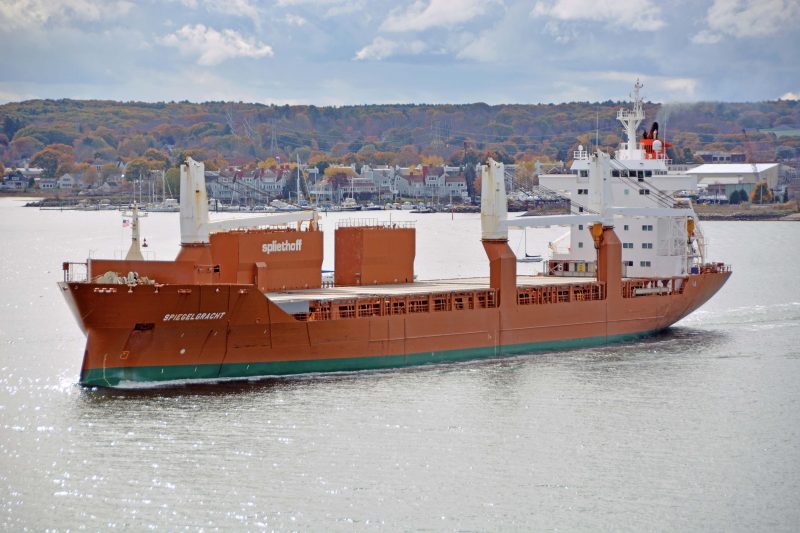
As Canadian ports began to be developed a decline set in during the inter-war years, and was only offset by increased fishing and shipbuilding at Portland, and particularly the Bath Iron Works yard at Bath (Maine) near the north end of Casco Bay. ‘Liberty’ standard ships in their hundreds were built during World War II by the New England Shipbuilding yards at Portland, and eighty destroyers were completed by the Bath Iron Works yard (Thirty ‘Gearing’ class, seventeen ‘Allen M. Sumner’ class, seventeen ‘Fletcher’ class and sixteen ‘Benson’ class). A destroyer was launched every seventeen days during the peak production years of 1943/44, with the Bath yard a key element to the successful outcome of the war against Japan in the Pacific. The shipbuilding industry at Bath began in 1884 and is still one of the leading industries of the Casco Bay area today, with a $610.4 million contract signed in 2015 for the construction of one guided missile destroyer. The U.S. Navy has provided up to 86% of the yard orders in times of war, with merchant ships also built throughout its history until the last merchant vessel was completed in 1983. In 1941, an important oil pipeline was built to move huge quantities of crude oil to Canadian refineries, and started a renaissance in port activity.
The Port In Post-War Years
New England coastal voyages on the route between Boston and Yarmouth (NS) were operated until 1954 by Eastern Steamship Lines. Bluenose 6,419/55 from the Lauzon yard of Davie Shipbuilders Ltd. took over from Bar Harbour (Maine) to Yarmouth for Canadian National Railways and later CN Marine, she was named after the famous Grand Banks fishing and racing schooner. The Portland to Yarmouth service was resurrected in 1970 by Lion Ferry A/B, part of the Stena Line ferry empire. Lion Ferry A/B operated the ferry Prince of Fundy 5,500/70 between 1970 and 1976, the chartered Fred. Olsen ferry Bolero 11,344/73 from 1973 to 1976 and operated on this summer service on sub-charter from Commodore Cruise Line, and the ferry Caribe 11,979/68 between 1976 and 1981. CN Marine of Canada operated the ferry Marine Evangeline 2,794/74 between 1978 and 1982, and Prince of Fundy cruises operated the ferry Scotia Prince 11,968/72 between 1983 and 2004.
The graceful and streamlined Scotia Prince arrived at Portland from Yarmouth nightly at the summer sunset time of 2000 hours and then sailed in darkness for her six hour crossing to Yarmouth. This ferry was also operated by Scotia Prince Cruises in 2004 from the International Marine Terminal at Portland when air quality issues resulted in the building being condemned during the winter of 2005/06. Scotia Prince Cruises promptly closed down this passenger service to Yarmouth, which was operated by a fast Incat catamaran as the ‘CAT’ between 2006 and 2009 from the new Ocean Gateway International Terminal. The cancellation of the Yarmouth (NS) to Portland (Maine) ferry in 2009 was a minor disaster for both Portland and Yarmouth, founded in 1761 by Massachusetts planters. Scores of tourist related businesses suffered economic downturn, and after three years of lobbying and an independent report in 2012, the Nova Scotian provincial government finally agreed to invest in a new service starting in 2014. Nova Star Cruises Ltd. took over the route and ran it for the two summer seasons of 2014 and 2015. The vessel used was the 528 feet long Nova Star 27,444/11, a ro-pax built by ST Marine in Singapore for LD Lines, with a provisional name of Norman Leader for English Channel service. However, her contract was cancelled before completion and she lay under builder’s ownership from 2011 to 2014. The Province of Nova Scotia announced in October 2015 that after two summer seasons, her contract for the 2016 season would not be renewed. Nova Star was a cruise type of ferry with two restaurants, three bars, a casino, a duty free shop, children’s play area, a spa, an art gallery, and live onboard entertainment with passenger accommodation for 1,644 tourists in one class.
Canada based Bay Ferries then announced on 30th March 2016 that they had leased the fast catamaran Puerto Rico from the U.S. Navy, which had used it in the Hawaiian Islands, for the Portland to Yarmouth summer service of 2016. She would simply be marketed as the ‘CAT’, the same name that Bay Ferries had used for the fast Incat catamaran that had operated the route between 2006 and 2009.
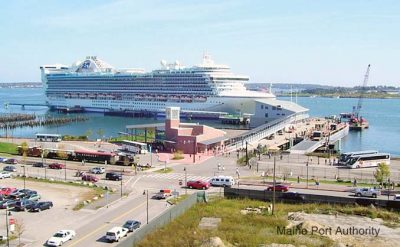
A new shiprepair facility had begun operation in 1970 by Bath Iron Works at the Maine State Pier and provided employment for hundreds of workers. The eleven piers in the port today are:-
- Maine State Pier (Portland Ocean Terminal)
- International Marine Terminal
- Motiva Terminal
- Portland Fish Pier
- Portland Pipeline Piers (1 and 2)
- Cargill Petroleum Terminal
- Mobil Oil Terminal
- Gulf Oil Terminal
- Sprague Energy Terminal
- Merrill Marine Terminal
The International Marine Terminal is located almost immediately underneath the main Casco Bay Bridge to South Portland, and the twin oil terminal piers are located near Cushing Point and the former slipways of the New England Shipbuilding Company. Deep draft vessels anchor one mile north of the ELN Racon buoy, and vessels of around 8.5 metre draft anchor in the Diamond Islands Roads anchorages, with light draft vessels anchored off Fish Point. The terminals of the oil majors transfer gasoline (petrol) to New England ports by coastal tanker, and receive asphalt tankers. Harbour towage is by McAllister tugs, and oil pollution operations are controlled by Maine Responder 1,335/93.
Portland Tanker Trade And The Portland-Montreal Pipeline
A regular tanker trade of more than two hundred tankers per year called until 2016 at the big Marine Oil Terminal on the south side of the busy Fore River in the city of South Portland (Maine), immediately downstream of the Portland Terminal Company railroad bridge over the river. The trade owed its existence to the deep penetration of the St. Lawrence by German U-boats during the ice free seasons of World War II, with many tankers and cargo ships sunk together with their valuable cargoes destined for the prosecution of the war in Europe against Nazi Germany. A pipeline was proposed to transfer the oil from the secure ice free port of Portland (Maine) north west to Montreal. The route chosen was to run alongside the existing Canadian National Railways (CNR) line that had been built in the 1850s for the Atlantic and St. Lawrence Rail Road, which was later taken over by the Grand Trunk Rail Road and then nationalised after World War I to become CNR.
The pipeline was ready to pump oil to Canada by 1941 using three separate pipelines, two of large diameter and one of small diameter, the latter discontinued in 1982. An enormous total of five billion barrels of crude oil was pumped over 75 years from Portland to Montreal, but this huge flow of crude oil was permanently halted at the beginning of 2016 when the Montreal refineries began receiving large quantities of ‘fracked’ oil by pipeline from the Alberta tar sands oilfields. There was now no need to move oil from Portland and is a permanent change, with the only possibility that refined oil might flow in the opposite direction for export from Portland (Maine).
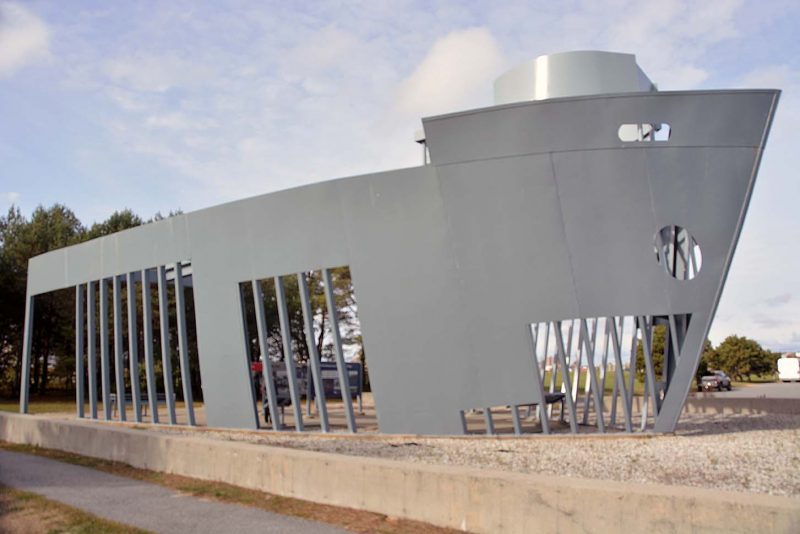
Shipbuilding At Portland And Bath (Maine)
A big total of 244 standard ‘Liberty’ ships of 10,000 dwt were built by the East and West yards of the New England Shipbuilding Corporation between 1943 and 1945 at Portland. The Portland output prior to this in 1941/42 were many ships of the standard ‘Ocean’ design of 10,000 dwt and based on the design of the Court Line tramp Dorington Court built on Wearside in 1939 by the North Sands yard of Joseph L. Thompson & Sons. The plans for this 10,000 dwt workhorse capable of economical steaming at eleven knots powered by a modest 2,500 horse power steam triple expansion engine were taken over to America for rapid fabrication by American block section methods wherever possible.
The wartime East and West yards were located near Cushing Point in South Portland and had a total of eleven building berths between them. Production ceased at the end of May 1945 after the cessation of the war in Europe. The Portland and Bath (Maine) shipbuilding workforces have since collaborated on many occasions, especially after the Bath Iron Works established a shiprepair yard at Portland in the late 1970s. The guided missile destroyer Samuel B. Roberts was completed at Bath in 1986 but was badly damaged two years later in a Middle East mining explosion that tore a big hole in her engine room and flooded two compartments. The heavy lift vessel Mighty Servant 2 delivered the ship to the Bath Iron Works drydock in Portland, while the Bath yard built a 315 tonne replacement engine room, which was floated south to Portland to be jacked up and slid into place where the damaged engine room had been cut out.
Bath (Maine) is a very long established shipbuilding centre known as the ‘City of Ships’, and is located twenty five miles north east of Portland near the north end of Casco Bay. The town of Bath has many fine stone houses built from the profits of this industry, as the Bath Iron Works yard is now the sole raison d’etre for its existence. The wooden ship Virginia was constructed here in 1608 for the British colonists of the area. A total of well over two thousand vessels have since been built at Bath by twenty yards, including many large four masted clippers or schooner rigged American sailing ships. One quarter of the American output of schooners and clipper ships were sailing the seven seas as products of Bath (Maine). The Maine Maritime Museum in Bath includes a small wooden boatbuilding yard, as well as a modern annex building with huge numbers of nautical models, paintings and shipbuilding memorabilia. There were several Bath shipbuilding companies including the New England Shipbuilding Company, and the New England Steamboat Company yard, which delivered the twin masted coastal steamer St. Croix of length 240 feet and moulded beam of forty feet to a subsidiary of the Eastern Steamship Company in 1895.
The yard of Percy & Small at Bath on the Kennebec river was on the site of the present Maine Maritime Musuem, with a sculpture outside of the famous six masted American schooner Wyoming built in 1909 by the yard. She was the largest wooden hulled vessel ever built in America, and the last to be built on the Eastern Seaboard. She was built of yellow pine with six inch planking and ninety diagonal iron cross-braces on each side of the hull. She measured 450.0 feet from her jib boom to her spanker boom tip, with a cargo carrying capacity of 6,000 tonnes of best Newport News coal to be carried northwards to Maine and Canada. On 11th March 1924, she anchored off Chatham (Mass) in Nantucket Sound, in company with a five masted American schooner, while fully loaded with 6,000 tonnes of coal from Norfolk, but a north east gale sprang up and she sank to the east of the Pollock Rip Lightship with the loss of her entire crew of fourteen.
The yard of Clark and Sewall at Bath built the first of two three masted sailing ships named Rappahannock in 1841 for a member of the Rothschild family with Capt. William Drummond as Master. She was 180 feet in length, 37 feet in beam, and 23.4 feet in depth with a gross tonnage of 1,133. She ran with general cargo to Liverpool in summer and to New Orleans to load cotton in winter.
Bath Iron Works was established in 1884 by General Thomas W. Hyde, locally born and a veteran of the Civil War. He concentrated on ship’s equipment for the first few years e.g. windlasses, capstans, iron equipment and parts for the fitting out of small iron gunboats. The wooden white painted hull of the paddle steamer Portland of 2,284 grt, built at a cost of $250,000, was launched at the yard on 14th October 1889, and became the greatest steamship disaster in New England on 26th November 1898. She was on her regular overnight voyage from Portland to Boston for the Portland Steam Packet Company (later renamed Portland Steamship Company) when she was hit by a massive blizzard, which claimed the lives of over four hundred people on land. She sank off Cape Ann near Gloucester (Mass) in 460 feet of water, taking with her between 193 and 245 passengers and crew, the exact total not being known as the only passenger list went down with the ship.
The yard completed the first iron hull of two iron gunboats, named Machias of length 190 feet, in the early 1890s. A vast list of merchant and naval vessels has been built since then, but particularly destroyers, including over twenty of the four funnel design in World War I, of which seven built at Bath were transferred to the Royal Navy during the early part of World War II in exchange for short term leases of British bases in the Caribbean. The yard had eight building berths in 1960 capable of building ships up to 600 feet in length, with an annual output of around 50,000 tonnes. The yard berths were lengthened by 1973 to build ships up to 750 feet in length with an annual output of 250,000 tonnes.

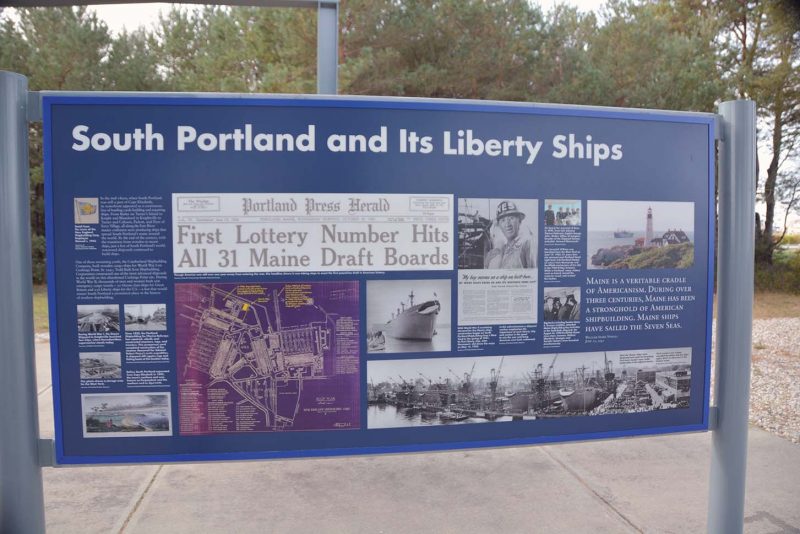
The Bath yard became a subsidiary of defence contractor General Dynamics in 1995, which began improving the yard by ending shipbuilding on slipways and instead having a horizontal transfer facility from the yard assembly shops to final assembly in a 750 feet long dry dock. The dry dock was built by the Jiangdu Yuchai Shipbuilding Company in China at a cost of $27 million and the new block prefabrication system of shipbuilding was in use in 2001.
A snapshot of this prodigious output over 125 years includes:-
Destroyers, gunboats and frigates with a huge total of over 220 built from 1890 to the present day.
The three funnelled battleship Georgia in March 1906, one of a class of five, armed with four 12” guns, eight 8” guns, twelve 6” guns, twelve 3” guns and four torpedo tubes. She cost $1.3 million to build and could steam at 19 knots powered by coal fired steam engines.
Monitor Nevada and ram vessel Katahdin.
Cruisers Cleveland and Chester in World War I, and the Leahy, Belknap and Ticonderoga classes of post World War II years.
Presidential yacht Williamsburg.
Lightvessels e.g. Diamond Shoal 71, Nantucket 66 and Nantucket 106.
Twin screw ferries Marthas Vineyard 1,089/23 and City of Lowell 2,975/94 for the New England Steamship Company for coastal services along the Maine and Massachusetts coastlines into beautiful New York harbour.
Tugs Daphne 305/32 and Turecamo Girls 199/33 for service in the Maracaibo oilfields of Venezuela.
Trawler Winchester 241/37 for fishing off the Grand Banks.
Yachts including the big graceful ‘J’ class Ranger of 1936, successful defender of the America’s Cup.
Container ships including the aft section of C.V. Sea Witch of 34,930 dwt in 1968 for American Export Lines, which was converted into a chemical tanker in 1978, and the full hull in 1978 of the Matson Line vessel Maui of 26,625 dwt and 1,626 TEU capacity including 368 refrigerated containers in five cellular holds, and steam turbine powered with a service speed of 21 knots. Two steam powered container ships of 1,070 TEU and five cellular holds were completed in 1979/80 as Argonaut and Resolute for the United States Trust Company of New York.
Tankers including sisters Falcon Champion and Falcon Leader of 34,080 dwt ordered in 1981 for Falcon Transport and completed in 1983.
Suction Dredger Essayons of 12,500 dwt completed as the last commercial vessel in 1983 for the U.S. Army Corps of Engineers with a hopper capacity of 4,588 cubic metres.
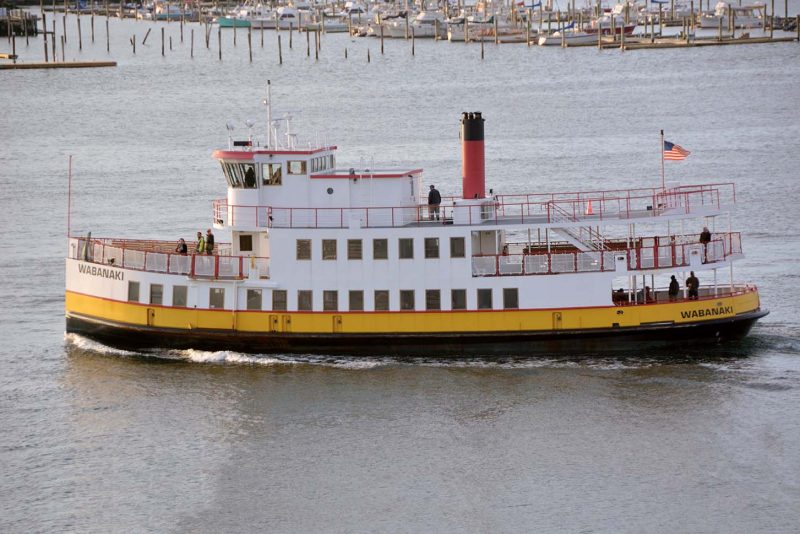
Cruise Ships At Portland Ocean Terminal
Portland has a long history of coastal cruising dating back over a century to the fine steam powered ‘hurricane deckers’ of the Eastern Steamship Company that sailed from Yarmouth (NS) to Bar Harbour (Maine), Portland (Maine), Boston (Mass) and New York City. In summer, some of their bigger vessels sailed south to Florida to cruise from Fort Lauderdale and Miami to the Bahamas and the Caribbean. Today, Portland receives an annual influx of over 220,000 cruise passengers per year in a variety of coastal and deep sea cruise ships to sightsee in this friendly city, with most attractions within walking distance of the Ocean Gateway Terminal. This terminal has 914.4 metres of deep water berths and alongside depth of 35 feet, and is equipped with a ro-ro ramp and a 100 tonne mobile crane. Some of these cruise lines are now described:-
American Cruise Lines
Coastal cruisers such as American Glory and Independence operate seven day cruises from Portland to six ports in Maine, including Bath, Bar Harbour, Castine, Camden, Rockland and Boothbay Harbour, or ten day cruises from Portland to Martha’s Vineyard, Nantucket Island, Boston (Mass), Providence (Rhode Island) and New York city.
Seas Cruises operate a new, small and stylish cruise ship on coastal cruises called Pearl Mist 5,109/08 and completed by the Halifax Shipyard in Nova Scotia.
Royal Caribbean International (RCI). Their megacruisers such as Grandeur of the Seas and Anthem of the Seas operate nine day cruises from Baltimore to ports in New England and Canada including Portland (Maine).
Carnival Cruise Lines. Their megacruisers such as Carnival Sunshine operate seven day cruises from New York city to ports in New England and Canada including Portland (Maine).
Celebrity Cruises. Their megacruisers including Celebrity Summit operate fourteen day cruises from Cape Liberty (New York) to Boston (Mass), Portland (Maine), Bar Harbour (Maine), Charlottetown (Prince Edward Island), Quebec, Sydney (CB), Halifax (NS) and return to Cape Liberty.
European Cruise Lines
Norwegian Cruise Line (NCL), Costa Line, Cunard Line, Regent Seven Seas, Oceania Cruises, Fred. Olsen Lines, Holland America Line, Silversea Cruises, Azamara Cruises, Aida Cruises and many others including Crystal Cruises of Japan call in throughout the summer and late year cruise season.
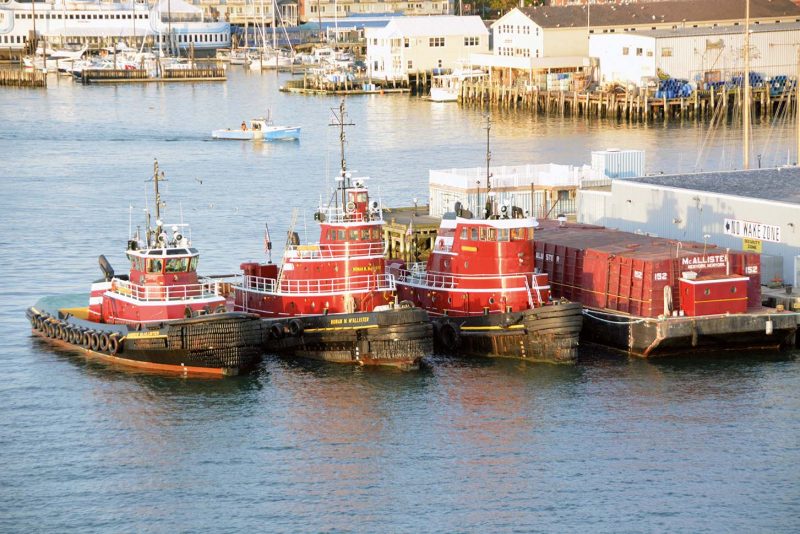
Postscript
The amount of container trade that Portland (Maine) could win from the big container port rivals in the Northern States of the U.S.A. was completely lost after the recession starting in late 2008. Container shipments totalled only 7,400 metric tonnes in 2011, but Icelandic shipping company Eimskip began a biweekly service in 2013 with 26 calls per year to increase the Portland container tonnage total to 105,523 metric tonnes in 2015. Maine State grants to Portland have included a container crane, a paved container yard to load, unload and store containers with plug units for refrigerated cargo. A new rail connection to Ayers (Mass) with containers moved three times per week has also boosted container ship traffic. Eimskip hope to increase the service to Iceland to weekly in 2020. The redevelopment of Portland has been given a boost by large tourist numbers, who can enjoy 3,478 miles of Maine coastline and its thousands of lakes.
Maine has been a Free State within the U.S. Union since 1820, and was balanced by the admission of Missouri as a Slave State at the same time. British troops had occupied much of Maine in 1812 and a British fleet sailed into Chesapeake Bay, but border disputes with New Brunswick in British Canada have long been forgotten. Maine is also the most northerly State of the Union, sharing with the States of New England gorgeous autumn tints of red, brown and yellow in her forests. Casco Bay Lines operates small tourist excursion boats to the equally beautiful outlying Calendar Islands, Peaks Island and several other islands offshore from Portland Ocean Terminal. Regular year round passenger, freight, mail and small car ferries run to Peaks Island, Long Island, Chebeague Island and Orr’s Island.
Full details are on their website at cascobaylines.com, with full details of the ports of Portland and Bath also at portofportlandmaine.org and maineports.com.
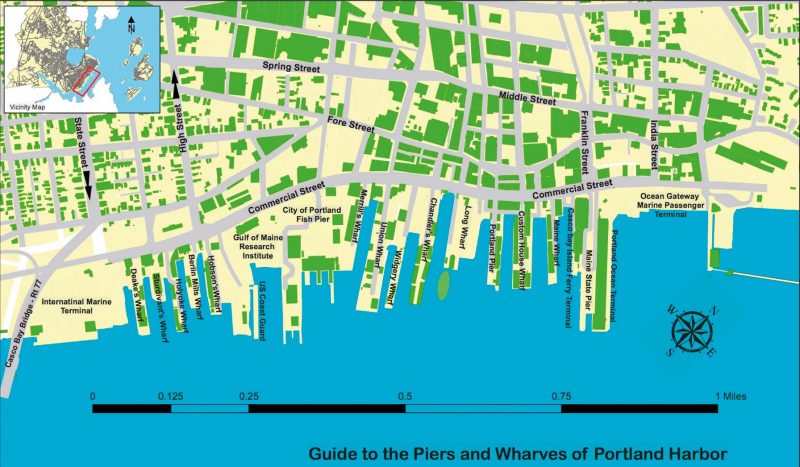
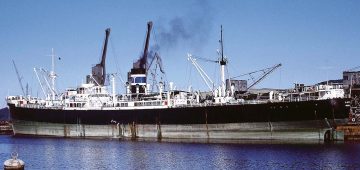



Comments
Sorry, comments are closed for this item